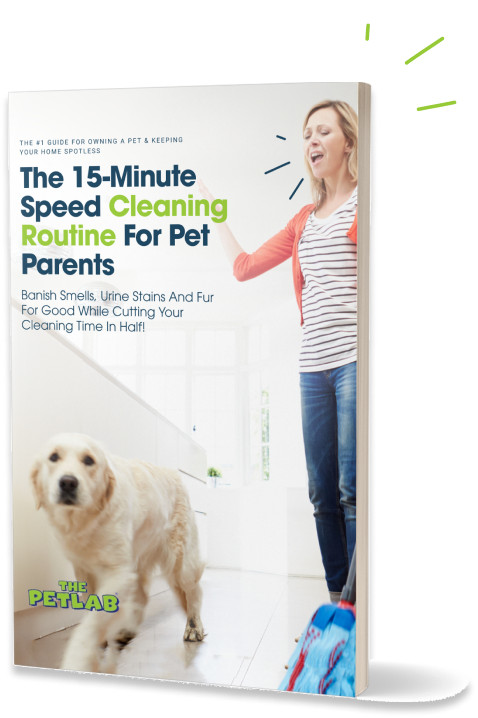Even if it’s just a few drops of pee here and there, Fido’s messes are enough to drive even the most patient pawrent nuts.
Yes, you love your pup—no doubt about it! But you’re not fond of cleaning. Or the costs that come with damaged interiors. 💸
Thankfully, there are solutions to even the most challenging potty-related problems.
7 ways to stop your dog from urinating in the house
Tip #1: Train your dog
Best for: Puppies 8 weeks and up until fully potty trained.
Reason: Puppies pee in unwanted places for so long as they haven’t been successfully housebroken. The only long-term solution is to start potty training as early as possible.
Recommendation: Use these toilet training tips to get you off on the right foot, then familiarise yourself with puppy potty regression.
Tip #2: Observe your dog
Best for: When you’re first getting to know your new puppy.
Reason: Dogs are creatures of habit, but you won’t know those habits unless you keep track of them.
To put that into perspective, we have a few questions:
- How often does your pet pee and poo in a day?
- When does the urge to urinate kick in after eating and drinking?
- What kind of activities trigger the need to pee?
If you can't answer all those questions, you're in for persistent potty problems.
Recommendation: Keep a journal (or download a tracking app) and note when your puppy has to answer the call of nature. You will soon spot patterns that make taking your dog out for toilet breaks easier than ever!
Tip #3: Switch to enzymatic cleaners
Best for: Households with pets, period.
Reason: In case you didn't know, standard cleaning products are not formulated to break down the odour-causing components in pet urine. That means a one-time accident can turn your dog into a habitual offender—if the original mess isn't handled adequately. That is, for so long as he can sniff out the spots he peed in before, expect him to relieve himself indoors again and again.
Recommendation: Stock up on enzyme-based cleaning products like PetLab’s E.N.Zyme Solution Stain & Odour Remover to prevent your pet from peeing in the house.
Tip #4: Neuter/spay your dog
Best for: Male dogs and multi-dog households.
Reason: Dogs are territorial creatures. "What’s mine is mine; what’s yours is also mine.” 😛 That’s why Fido will sprinkle his tinkle on food bowls, new toys, rugs, and even your bed. Nothing is off-limits! This natural instinct to mark territory (and resources) that "belongs" to him is called urine marking.
Recommendation: Neutering/spaying can drastically reduce your pet’s drive to scent mark, but it’s not a guaranteed fix. Talk to your vet about this.
Tip #5: Screen for medical conditions
Best for: Housebroken dogs that suddenly start peeing indoors for no apparent reason.
Reason: A wide range of medical conditions could cause your dog to “do a number one” in the house. These include:
- Bladder and kidney diseases such as a urinary tract infection (UTI), kidney stones, tumours, and cancers
- Endocrine diseases like Cushing’s syndrome and diabetes
- Prostate problems
- Joint pain from arthritis
- Anxiety
- Doggy dementia and other neurological disorders
- Age-related incontinence
Recommendation: Some causes of incontinence can be treated. Others (like aging) cannot, which is when dog diapers help keep dribble off your floors, fabrics, and furniture. Consult with your vet for more information.
Tip #6: Keep calm and carry on
Best for: Excitable dogs prone to celebrating your return home with tail wagging, jumping, and the gift of pee.
Reason: Sometimes, you’re the problem. To be more precise, your high-pitched voice and enthusiastic greeting can trigger excitement urination. Like submissive peeing, this behaviour is more common in young dogs. Having said that, it can carry through into adulthood if not handled appropriately. FYI: Reading your pet the riot act for messing up does not work.
Recommendation: Instead of a high-energy greeting, speak calmly and avoid eye or physical contact when you get home. If you must, ignore your dog until he settles down.
Tip #7: Regular potty breaks
Best for: Dogs of all ages.
Reason: Whether puppy, young adult, or senior dog - your furry friend should not have to hold his urine in all day. (Hey, we bet you can’t do it either!) So, make sure you have a backup plan for extra busy days.
Recommendation: Recruit (OK, sweet talk ☺️) a family member to help. Hire a professional dog walker. Or sign your pet up for doggy daycare. What matters is that Fido should get at least 3 to 5 comfortable toilet breaks daily.
Disclaimer: This post is for informational purposes only. It is not and does not intend to be a substitute for professional veterinarian advice, diagnosis, or treatment. Reliance on any information on this website is at your own risk. Always consult with your veterinarian.


